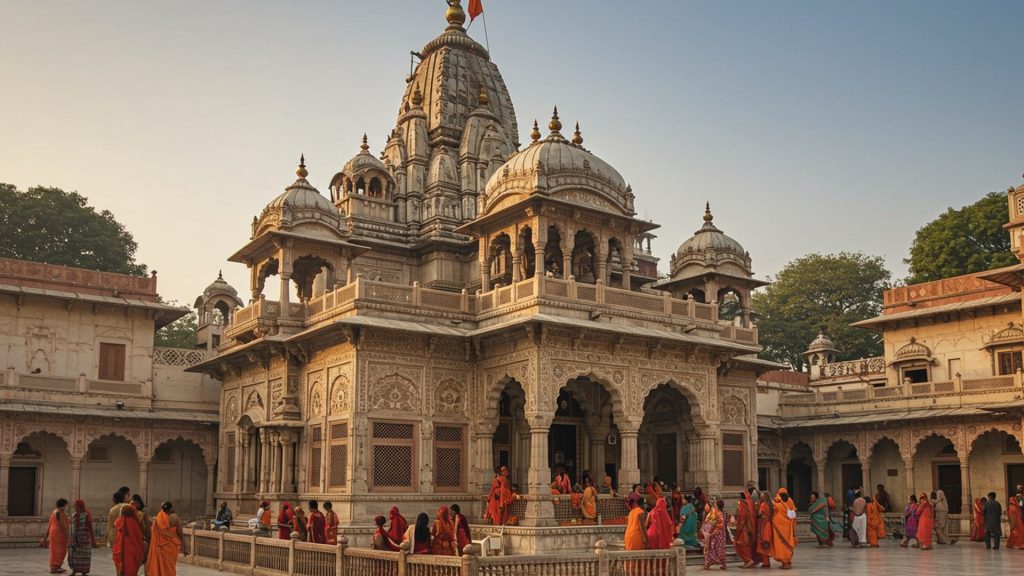A proposed law for the revered Banke Bihari Temple is now before the UP Assembly, sparking immediate and intense debate. Unveiled today, this significant bill aims to reshape the temple’s administration and finances. it faces fierce pushback from local residents and priests. They argue the bill threatens long-standing traditions and reduces community control over the sacred site. The government’s move has instantly created deep concern, as many fear for the future of the holy site’s autonomy. The tension builds as all eyes turn to the assembly, where the fate of this crucial religious institution hangs in the balance.
New Proposal for a Major Temple
The Uttar Pradesh government recently introduced a new proposal, known as the Uttar Pradesh Shri Banke Bihari Ji Temple Trust Bill, 2025, in the state assembly. This new bill aims to create a special group, called a trust, to manage the famous Banke Bihari Temple in Vrindavan, Mathura district. The move replaces an earlier official order, known as an ordinance, that was put in place on May 26. The new bill was brought forward on Wednesday, August 13, 2025, during the ongoing Monsoon session of the assembly. It was later approved by both the state legislative assembly and the legislative council on Thursday, August 14, 2025. The Banke Bihari Temple is a very old and crucial place of worship in Vrindavan. It is dedicated to Lord Krishna. Large numbers of devotees visit this temple, especially during special festivals. Over the years, the number of visitors has grown, causing challenges in managing the crowds and ensuring everyone’s comfort and safety. The temple is spread over about 870 square meters. only about 365 square meters is used as a viewing area for devotees. The path leading to the temple is very narrow, which makes it hard for the many visitors to move freely. A serious incident on August 20, 2022, highlighted these problems when two devotees died because of too many people. This event showed how urgently better crowd management was needed at the temple. The government stated that the new trust aims to make the temple administration better and use its funds for improvements. They have compared these plans to similar large-scale projects at other vital religious sites in Ayodhya and Kashi.
What the New Proposal Says
The new Banke Bihari Temple Trust Bill, 2025, gives clear rules for how the temple will be managed. A key part of the bill is that the new trust will have rights over all the offerings and properties of the temple. This includes things that can be moved and things that cannot, like land and buildings. It covers money, jewelry, bank drafts, cheques. donations of all kinds, whether they are given by hand or sent by mail. The trust will also be in charge of many daily operations. For example, it will decide when devotees can visit the temple. It will also be responsible for hiring priests and setting their pay. Ensuring the safety of all devotees and visitors will also be a key task of this trust. The bill states that the trust will carry out plans for improving the temple area and building a proposed corridor. To do this work, the trust will seek advice from experts in old buildings, engineers. architects, as well as well-known institutions. The aim is to put in place systems for easier entry and exit, special paths for older people and those with disabilities, clean drinking water, places to sit. facilities for managing queues of people. Other planned improvements include cow shelters, community kitchens, rest houses, hotels, exhibition rooms. waiting areas. The new trust will have a total of 18 members. This includes 11 nominated members and 7 members who are part of the trust because of their official positions. The state government will choose the 11 nominated members. Among them will be three respected persons from the Vaishnav traditions, such as religious teachers or heads of monasteries. There will also be three respected persons from other Sanatan Dharma traditions. Also, three well-known individuals from any part of Sanatan Dharma, who are educators, scholars, business people, or social workers, can be included. Two members will also come from the Goswami families who currently perform duties at the temple. The 7 official members will include the Mathura District Magistrate, the Senior Superintendent of Police of Mathura, the Municipal Commissioner of Mathura. the Chief Executive Officer of the Uttar Pradesh Braj Teerth Vikas Parishad. An officer from the state government’s Charitable Department and the Chief Executive Officer of the Shri Banke Bihari Ji Temple Trust will also be official members. The bill makes it clear that all trustees must be Hindus and follow Sanatan Dharma. For property deals, the trust can buy or sell property up to 20 lakh rupees on its own. anything more than this amount will need government approval. The government has also given assurances that the traditional customs, festivals. rituals that have been followed since the time of Swami Haridas, who founded the temple, will continue without any changes or interruptions.
Why the Proposal Was Made
The proposal to form a trust for the Banke Bihari Temple comes after a long history of the temple’s growth and the increasing challenges of managing it. The Banke Bihari Temple is a very old and respected temple in Vrindavan, Mathura. It is dedicated to Lord Krishna, who is believed to be the combined form of Radha and Krishna. The temple’s story goes back to the 16th century, when it was established by Swami Haridas, a famous saint and musician. According to old stories, Lord Krishna appeared before Swami Haridas in Nidhivan while he was performing devotional music. This divine form became known as Banke Bihari. The idol was initially kept in Nidhivan, where Swami Haridas worshipped it. The current temple building was constructed around 1864 to house the beloved idol. For many centuries, the Goswami family members have been taking care of the temple and its worship traditions. The temple has some unique practices. For instance, no bells are used during worship because it is believed they might disturb the deity’s rest. Also, the curtain covering the deity is opened and closed every five minutes during viewing times. This is because there is a belief that if devotees stare at the idol for too long without a break, Banke Bihari might leave the temple and go home with them. With millions of devotees visiting every year, especially during big festivals like Janmashtami and Holi, the old ways of managing the temple have become difficult to handle the large crowds. The government stated that the bill aims to bring the temple’s management under a well-organized body that can handle the growing number of visitors and the large amount of offerings received. The death of two devotees in August 2022 due to overcrowding highlighted the urgent need for a more structured approach to ensure safety and better facilities. The state government has stated that this bill is meant to improve administration and is not meant to get in the way of the religious customs of the temple. rather to manage its everyday, non-religious activities.
Different Groups Have Different Views
The introduction of the Banke Bihari Temple Trust Bill has led to different views among various groups involved with the temple. The Uttar Pradesh government stated that the bill is necessary for better administration and to improve facilities for the thousands of devotees who visit daily. They argue that the trust will help streamline operations and ensure the safety of visitors, while also making sure that the old traditions of the temple, linked to Swami Haridas, will continue without change. But, the Goswami priests, who have been managing the temple for hundreds of years and currently own it, have strongly opposed the bill. They see the government’s move as an attempt to take over the temple’s money and its control. Some priests have expressed concerns that this bill could take away their means of earning a living. They argue that the temple became respected under their care and that the government is trying to take it over unfairly. Some Goswami priests even said that if the government does not change its decision, they might remove the idol, which they say their ancestors installed in 1864. The matter has also involved the Supreme Court of India. The Supreme Court had put a temporary hold on the earlier ordinance from May 26. The court also stopped its earlier order from May 15 that allowed temple funds to be used for a corridor project, saying that crucial groups like the Goswami community were not heard before that decision was made. The Supreme Court also questioned why the Uttar Pradesh government was in a great hurry to issue the ordinance. As an temporary measure, the Supreme Court, in its ruling on August 8, created a 14-member temporary committee. This committee is led by a retired judge from the Allahabad High Court, Justice Ashok Kumar. It also includes local officials and some Goswamis. its job is to look after the daily running of the temple and the law and order situation around it. The court also directed the Allahabad High Court to decide on the validity of the ordinance. The state government has denied that it plans to take over the temple’s money from the Goswamis.
Next Steps for the Proposal
The Banke Bihari Temple Trust Bill, 2025, has been approved by the Uttar Pradesh legislative assembly and council. This means the state government’s efforts to create a formal trust for the temple’s management have moved forward. While the bill has been passed in the assembly, discussions and debates around its provisions were held. For example, a member of the Samajwadi Party tried to propose changes to the bill during its discussion. the proposal was not accepted. The Supreme Court had earlier asked the Allahabad High Court to review the legality of the ordinance that the bill now replaces. The state government stated that the temple’s operations will follow the instructions given by the Supreme Court at this time. The Supreme Court has created an interim committee to oversee the temple’s daily affairs while the legal challenges continue. The government hopes that by establishing this trust, it can provide better facilities for devotees and ensure efficient management of the temple, while also respecting its long-standing traditions.

